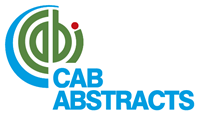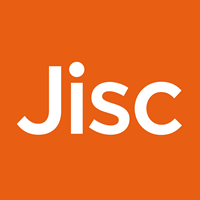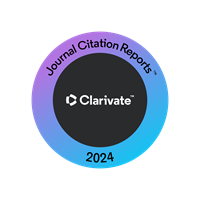Growing apples in tropical semiarid: N and K fertigation
Abstract
Apple tree has been experimentally grown Brazilian tropical semiarid. In these new regions, fertilizing management research for N and K is crucial to reach apple high yields. Therefore, an experiment was conducted to evaluate the effect of N and K fertilizing on fruit production, leaf chlorophyll and N and K nutritional status of apple cv. ‘Julieta’ grown in Brazilian tropical semiarid. The experimental design used was randomized blocks with treatments disposed in a factorial arrangement (4 x 4) referring to nitrogen doses (30, 60, 90, and 120 g of N plant-1) and potassium doses (30, 60, 90, and 120 g of K2O plant-1), with three replications and three plants in each parcel. ‘Julieta’ apple trees propagated by grafting (with ‘M9 filter and Maruba rootstock) and transplanted in 2013 were used in this study. The following variables were evaluated: i) fruit production (kg plant-1); ii) number of fruits (in a plant); iii) leaf chlorophyll index (‘a’, ‘b’, and total); and iv) leaf N and K concentrations (g kg-1). N and K doses effects depend on the consecutive production cycles of apple cv. ‘Julieta’ grown in tropical semiarid. An adequate N supply is very important for the subsequent production cycle. K fertilization until 120 g plant-1 of K2O is not enough to supply K demand of apple cv. ‘Julieta’ grown in tropical semiarid. In tropical semiarid, 60-90 g plant-1 of N through fertirrigation is enough for ‘Julieta’ apple production.
Downloads
References
Associação Brasileira de Produtores de Maçã [ABMP]. (2018). Estatísticas. Retrieved on July 10, 2020 from http://www.abpm.org.br/
Bataglia, O. C., Furlani, A. M. C., Teixeira, J. P. F., Furlani, P. R., & Gallo, J. R. (1983). Métodos de análise química de plantas. Campinas, SP: Instituto Agronômico.
Brunetto, G., Melo, G. W. B., Toselli, M., Quartieri, M., & Tagliavini, M. (2015). The role of mineral nutrition on yields and fruit quality in grapevine, pear and apple. Revista Brasileira de Fruticultura, 37(4), 1089-1104. DOI: https://doi.org/10.1590/0100-2945-103/15
Castro, D. C., Micheloud, N., Buyatti, M., & Gariglio, N. F. (2015). Carga ótima de frutos na macieira ‘princesa’ de baixo requerimento em frio invernal: resultados preliminares. Revista Brasileira de Fruticultura, 37(2), 517-523. DOI: https://doi.org/10.1590/0100-2945-088/14
Cavalcante, Í. H. L., Silva Júnior, G. B., Santos, E. M., & Lima, A. M. N. (2016). Relationship between chlorophyll meter readings and leaf nitrogen concentration in papaya (Carica papaya L.). Philippine Journal of Crop Science, 41(1), 75-79.
Empresa de Pesquisa Agropecuária e Extensão Rural de Santa Catarina. [EPAGRI]. (2006). A cultura da macieira (1. ed.). Florianópolis, SC: Pallotti.
Ernani, P. R., Dias, J., & Flore, J. A. (2002). Annual additions of potassium to the soil increased apple yield in Brazil. Communications in Soil Science and Plant Analysis, 33(7-8), 1291-1304. DOI: https://doi.org/10.1081/CSS-120003888
Food and Agriculture Organization [FAO]. (2019). Statistics. Retrieved on July 10, 2020 from http://www.fao.org/statistics/en/
Gutiérrez-Gamboa, G., Román, S. M.-S., Jofré, V., Rubio-Bretón, P., Pérez-Álvarez, E. P., & Garde-Cerdán, T. (2018). Effects on chlorophyll and carotenoid contents in different grape varieties (Vitis vinifera L.) after nitrogen and elicitor foliar applications to the vineyard. Food Chemistry, 269, 380-386. DOI: https://doi.org/10.1016/j.foodchem.2018.07.019
Lima, F. N., Yamanishi, O. K., Pires, M. C., Saba, E. D., Pereira, A. R., & Miranda, G. S. (2020). Ecophysiology of the Southern Highbush blueberry cv. Biloxi in response to nitrogen fertigation. Comunicata Scientiae, 11, e3245. DOI: https://doi.org/10.14295/cs.v11i0.3245
Lopes, P. R. C., Oliveira, I. V. M., Silva, R. R. S., & Cavalcante, Í. H. L. (2013). Growing princesa apples under semiarid conditions in northeastern Brazil. Acta Scientiarum. Agronomy, 35(1), 93-99. DOI: ttps://doi.org/10.4025/actasciagron.v35i1.15066
Lopes, P. R. C., Oliveira, I. V. M., Silva-Matos, R. R. S., & Cavalcante, Í. H. L. (2012). Caracterização fenológica, frutificação efetiva e produção de maçãs ‘Eva’ em clima semiárido no Nordeste Brasileiro. Revista Brasileira de Fruticultura, 34(4), 1277-1283. DOI: https://doi.org/10.1590/S0100-29452012000400038
Lu, Y.-L., Yang, X.-L., Li, R., Li, S.-L., & Tong, Y.-A. (2015). Effects of different potassium fertilizer application periods on the yield and quality of Fuji apple. The Journal of Applied Ecology, 26(4), 1179-1185.
Malavolta, E., Vitti, G. C., & Oliveira, S. A. (1997). Avaliação do estado nutricional das plantas: princípios e aplicações (2. ed.). Piracicaba, SP: Associação Brasileira para Pesquisa da Potassa e do Fosfato.
Miranda, J. M. S., Cavalcante, Í. H. L., Oliveira, I. V. M., & Lopes, P. R. C. (2015b). Advances on apple production under semiarid climate: N Fertigation. Emirates Journal of Food and Agriculture, 27(10), 744-748. DOI: https://doi.org/10.9755/ejfa.2015-04-075
Miranda, J. M. S., Cavalcante, Í. H. L., Oliveira, I. V. M., Lopes, P. R. C., & Assis, J. S. (2015a). Fruit quality of ‘Eva’ e ‘Princesa’ apples grown under nitrogen fertigation in semiarid climate. Revista Brasileira de Engenharia Agrícola e Ambiental, 19(10), 967-972. DOI: https://doi.org/10.1590/1807-1929/agriambi.v19n10p967-972
Nachtigall, G. R., Basso, C., & Freire, C. J. S. (2004). Nutrição e adubação de pomares. In G. R. Nachtigall (Ed.), Maçã: produção (p. 63-77). Bento Gonçalves, RS: Embrapa Uva e Vinho.
Nava, G. (2010). Produção e crescimento da macieira ‘fuji’ em resposta à adubação orgânica e manejo de plantas espontâneas. Revista Brasileira de Fruticultura, 32(4), 1231-1237. DOI: https://doi.org/10.1590/S0100-29452010000400034
Nava, G., & Dechen, A. R. (2009). Long-term annual fertilization with nitrogen and potassium affect yield and mineral composition of ‘fuji’ apple. Scientia Agricola, 66(3), 377-385. DOI: https://doi.org/10.1590/S0103-90162009000300013
Nava, G., Nuernberg, N. J., Pereira, A. J., & Dechen, A. R. (2007). Adubação de crescimento de macieira cv. Catarina sobre porta-enxerto marubakaido em São Joaquim-SC. Revista Brasileira de Fruticultura, 29(2), 359-363. DOI: https://doi.org/10.1590/S0100-29452007000200033
Pereira, L. S., Silva, E. M., Lacerda, J. J. J., Ratke, R. F., Lima, C. J. G. S., & Santos, T. O. S. (2020). Phytotechnical parameters and yield of watermelon plants under different irrigation and nitrogen levels. Comunicata Scientiae, 11, e3131. DOI: https://doi.org/10.14295/cs.v11i0.3131
Römheld, V., & Kirkby, E. A. (2010). Research on potassium in agriculture: needs and prospects. Plant and Soil, 335(1), 155-180. DOI: https://doi.org/10.1007/s11104-010-0520-1
Serra, S., Leisso, R., Giordani, L., Kalcsits, L., & Musacchi, S. (2016). Crop load influences fruit quality, nutritional balance, and return bloom in ‘Honeycrisp’ apple. Hortscience, 51(3), 236-244. DOI: https://doi.org/10.21273/HORTSCI.51.3.236
Souza, F., Argenta, L. C., Nava, G., Ernani, P. R., & Amarante, C. V. T. (2013). Qualidade de maçãs ‘fuji’ influenciada pela adubação nitrogenada e potássica em dois tipos de solo. Revista Brasileira de Fruticultura, 35(1), 305-315. DOI: https://doi.org/10.1590/S0100-29452013000100035
Treder, W. (2010). Crop loading studiem with ‘Jonagold’ apple tree. Journal of Fruit and Ornamental Plant Research, 18(1), 59-69.
Wang, Y., & Wu, W.-H. (2017). Regulation of potassium transport and signaling in plants. Current Opinion in Plant Biology, 39, 123-128. DOI: https://doi.org/10.1016/j.pbi.2017.06.006
Zhang, W., Zhang, N. S., Zhao, J. J., Guo, Y. P., Zhao, Z. Y., & Mei, L. X. (2017). Potassium fertilization improves apple fruit (Malus domestica Borkh. Cv. Fuji) development by regulating trehalose metabolismo. The Journal of Horticultural Science and Biotechnology, 92(5), 539-549. DOI: https://doi.org/10.1080/14620316.2017.1304165
DECLARATION OF ORIGINALITY AND COPYRIGHTS
I Declare that current article is original and has not been submitted for publication, in part or in whole, to any other national or international journal.
The copyrights belong exclusively to the authors. Published content is licensed under Creative Commons Attribution 4.0 (CC BY 4.0) guidelines, which allows sharing (copy and distribution of the material in any medium or format) and adaptation (remix, transform, and build upon the material) for any purpose, even commercially, under the terms of attribution.




















































